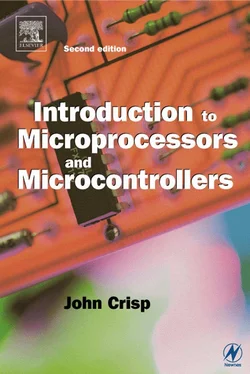John Crisp - Introduction to Microprocessors and Microcontrollers
Здесь есть возможность читать онлайн «John Crisp - Introduction to Microprocessors and Microcontrollers» весь текст электронной книги совершенно бесплатно (целиком полную версию без сокращений). В некоторых случаях можно слушать аудио, скачать через торрент в формате fb2 и присутствует краткое содержание. Год выпуска: 2004, ISBN: 2004, Издательство: Elsevier, Жанр: Компьютерное железо, на английском языке. Описание произведения, (предисловие) а так же отзывы посетителей доступны на портале библиотеки ЛибКат.
- Название:Introduction to Microprocessors and Microcontrollers
- Автор:
- Издательство:Elsevier
- Жанр:
- Год:2004
- ISBN:0-7506-5989-0
- Рейтинг книги:3 / 5. Голосов: 1
-
Избранное:Добавить в избранное
- Отзывы:
-
Ваша оценка:
- 60
- 1
- 2
- 3
- 4
- 5
Introduction to Microprocessors and Microcontrollers: краткое содержание, описание и аннотация
Предлагаем к чтению аннотацию, описание, краткое содержание или предисловие (зависит от того, что написал сам автор книги «Introduction to Microprocessors and Microcontrollers»). Если вы не нашли необходимую информацию о книге — напишите в комментариях, мы постараемся отыскать её.
Introduction to Microprocessors and Microcontrollers — читать онлайн бесплатно полную книгу (весь текст) целиком
Ниже представлен текст книги, разбитый по страницам. Система сохранения места последней прочитанной страницы, позволяет с удобством читать онлайн бесплатно книгу «Introduction to Microprocessors and Microcontrollers», без необходимости каждый раз заново искать на чём Вы остановились. Поставьте закладку, и сможете в любой момент перейти на страницу, на которой закончили чтение.
Интервал:
Закладка:
The only technical information that is included in the initial announcement is a new bus system using ‘hypertransport’ technology which AMD claims to increase throughput by 50% over existing designs. Intel will have something to say about that claim, I expect. The clock speed of the first batch will be little different from the XP, around the 2.8 GHz, but the design will provide more scope for development and will be able to run programs at a higher speed.
Really exciting times ahead… over 3 GHz clock speeds, 64-bit computing and multiple instructions being carried out simultaneously. Sounds good.
The desktop speed Olympics is shared between the PowerPC 970, Pentium 4 and the Athlon 64 whereas the computer market is dominated by the IBM clones leaving just a minor role for the PowerPC 970 in the Apple-Mac. As we saw earlier, the result of any speed test does depend on the nature of the test. Having said that, and at the risk of irritating the fans of each, in the race for the overall speed freak the Athlon 64, when it is available, will appear to be the winner with the other two virtually shoulder to shoulder a pace behind. But it depends on the test chosen and we know that any speed king will be dethroned so very quickly.
A (very) approximate comparison based on the currently available information is shown in Table 14.1.
Table 14.1
| PowerPC 970 | Pentium 4 | Athlon 64 | |
|---|---|---|---|
| Clock speed | 2 GHz | 2.8 GHz | 2 GHz |
| Bus speed | 900 MHz | 533 MHz | 533 MHz |
| Bits | 64 | 32 | 64 |
| Process size | 0.13/ 0.09 microns | 0.13 microns | 0.13 microns |
| Op systems | OSX IBM linux | Windows | Windows |
| Comparative speed | 1988 | 1984 | 2372 |
| Max memory | Terabytes | 40 GB | Terabytes |
In each case, choose the best option.
1 Compared with the Pentium 4, the Athlon XP design has:
(a) faster FSB, running at 533 MHz.
(b) the same speed of FSB.
(c) slower FSB, running at 333 MHz.
(d) faster FSB, running at 2.8 GHz.
2 As the Pentium 4 and the Athlon XP are both using 0.13 micron technology:
(a) it does NOT imply any other similarities between the designs.
(b) they will both run at the same clock speed.
(c) they will have the same number of pins.
(d) the cache sizes are equal.
3 The three floating point execution units in the Athlon XP simultaneously handle store and load, multiply functions and:
(a) SIMD functions.
(b) add functions.
(c) divide functions.
(d) 3D NOW! functions.
4 When Branch prediction is correct it:
(a) increases the overall speed of running the program.
(b) increases the length of the pipeline.
(c) decreases the clock speed.
(d) prevents overheating of the microprocessor.
5 The Athlon Instruction cache has a capacity of:
(a) 256 kB.
(b) 32 bits.
(c) 64 kB.
(d) 384 MB.
15. Microcontrollers and how to use them
In the 1960s, electronics started to awake from its slumber that had used thermionic valve technology that was recognizably similar to circuits that had been built for thirty years. The pace of progress was gentle. The first semiconductor material was developed and the transistor came into use in just a few years. The photographic process used to design and produce the transistor quickly led to simple integrated circuits and the microprocessor.
No sooner had the microprocessor and the associated memories arrived in 1971 than it became obvious that the microprocessor was always accompanied by other circuits, like input/output devices, memory and timing circuits so it would be a good move to combine them into a single device.
We had a choice – we could keep everything general and universal and call it a microprocessor or design it for a single purpose and call it a microcontroller.
The multipurpose devices went into computers and even here we had a choice. Computers were either ‘microcomputers’ where price was a significant feature and these microprocessors had some built-in ROM and RAM. Soon, however, speed became the main feature as the prices began to fall and we could afford to equip our homes with computing power which equalled many offices of just a few years previously and the microprocessors became expensive and fast. Speed headlines drive the publicity machines as home and office computers became faster and faster. They sold in their millions. Meanwhile the single-purpose devices, really the descendents of the early microcomputers, were developed further and made really cheaply, sold by the billion and were never mentioned. They power the pocket calculator, video recorders, cameras, microwaves, washing machines and greetings cards that play music – in fact almost anything vaguely electronic.
Just a thought
The microcontrollers outnumber the population of the world many times and as mentioned earlier we are likely to be sharing our homes with, possibly, fifty of them. They are in every essential industry – food production, transport, communications, research, weaponry, power generation, medicine, heating and air conditioning – there is little that we rely on that does not use a microcontroller. If they learn to communicate independently of us, they may develop their own agenda. Now there’s a thought.
Once we have learned to drive, most vehicles are easily recognized as being very similar. We are happy with the general idea and can concentrate on the minor differences. Microcontrollers are much the same. Having already become familiar with the basic building blocks of the simple microprocessor in Chapter 8, we can move very easily into the microcontroller. It is not surprising then to find that all microcontrollers are basically very similar.
To give an overall impression of the range of microcontrollers available we are going to look at three popular ranges. The first is the 8051, probably the most widely used microcontroller, over twenty years old and continuously developed by many different companies and showing no signs of fading away. The next is from the AVR family produced by the Atmel Corporation, one of the leaders in this field. From this range we look at the AT90S/LS2343 one that is small, modern and RISC. The final one will be explored in Chapter 16.
Probably the transition between the microcomputer to the microcontroller occurred with the Intel 8048 as we saw in Chapter 11. The 8048 added on-chip RAM, ROM and a timer so it could be used as a single purpose device such as controlling a keyboard – it was, in fact, a microcontroller.
With the experience gained by using this, it became apparent that there was a significant market for a microcontroller. In 1980, Intel launched the 8051 which, twenty-three years later, is alive and well. In fact very well indeed. It is probably the most popular microcontroller ever. It is made by about 44 suppliers. These suppliers have often added some extra features to make versions or ‘variants’ as they are called particularly suitable for specific jobs. There are at least 92 variants all compatible with the original code. Even within variants, there are a series of options that lifts the total number of members of the 8051 family to several hundred.
Numbering
The device numbering is not very obvious as many microcontrollers are available from several different suppliers with their own product code. They then produce a group of basically similar devices with minor changes like different operating voltages or differing amount of RAM and ROM on-board memory – these groups are referred to as ‘families’.
Читать дальшеИнтервал:
Закладка:
Похожие книги на «Introduction to Microprocessors and Microcontrollers»
Представляем Вашему вниманию похожие книги на «Introduction to Microprocessors and Microcontrollers» списком для выбора. Мы отобрали схожую по названию и смыслу литературу в надежде предоставить читателям больше вариантов отыскать новые, интересные, ещё непрочитанные произведения.
Обсуждение, отзывы о книге «Introduction to Microprocessors and Microcontrollers» и просто собственные мнения читателей. Оставьте ваши комментарии, напишите, что Вы думаете о произведении, его смысле или главных героях. Укажите что конкретно понравилось, а что нет, и почему Вы так считаете.












